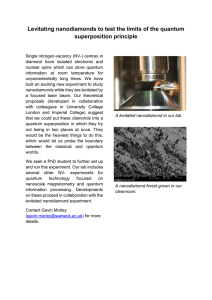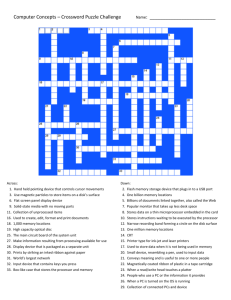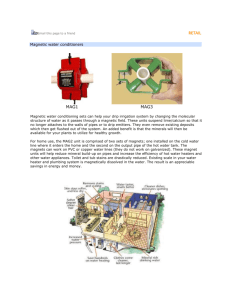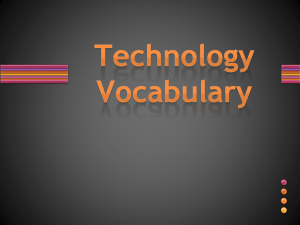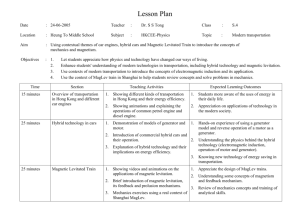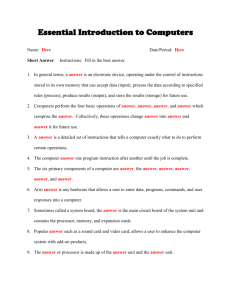Title
advertisement
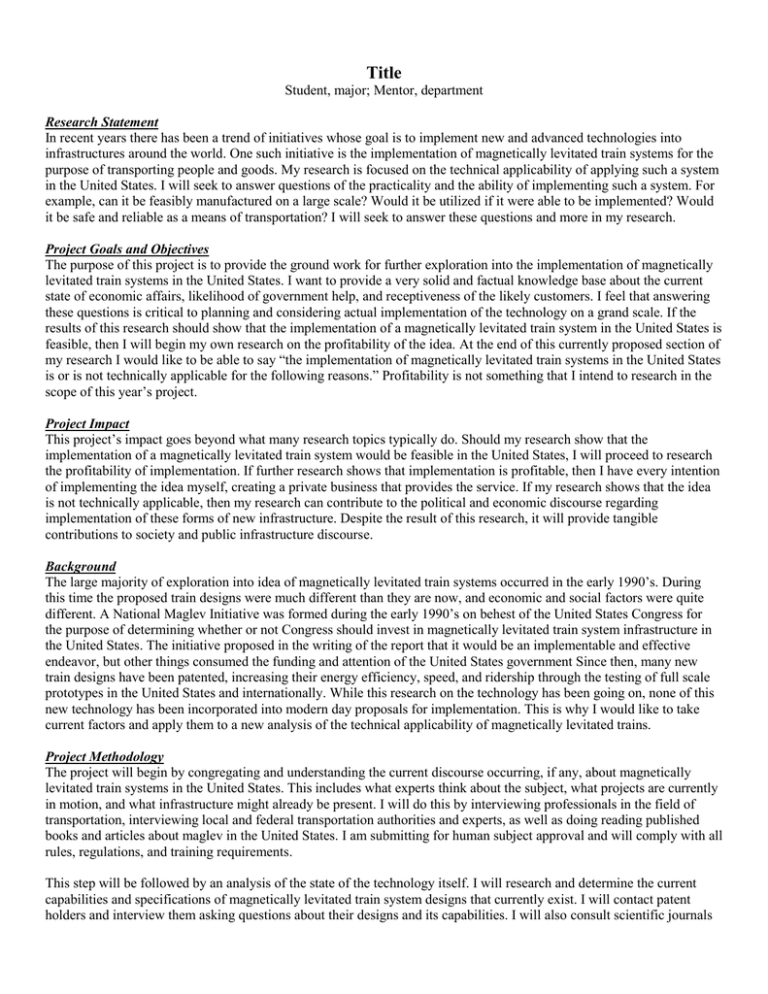
Title Student, major; Mentor, department Research Statement In recent years there has been a trend of initiatives whose goal is to implement new and advanced technologies into infrastructures around the world. One such initiative is the implementation of magnetically levitated train systems for the purpose of transporting people and goods. My research is focused on the technical applicability of applying such a system in the United States. I will seek to answer questions of the practicality and the ability of implementing such a system. For example, can it be feasibly manufactured on a large scale? Would it be utilized if it were able to be implemented? Would it be safe and reliable as a means of transportation? I will seek to answer these questions and more in my research. Project Goals and Objectives The purpose of this project is to provide the ground work for further exploration into the implementation of magnetically levitated train systems in the United States. I want to provide a very solid and factual knowledge base about the current state of economic affairs, likelihood of government help, and receptiveness of the likely customers. I feel that answering these questions is critical to planning and considering actual implementation of the technology on a grand scale. If the results of this research should show that the implementation of a magnetically levitated train system in the United States is feasible, then I will begin my own research on the profitability of the idea. At the end of this currently proposed section of my research I would like to be able to say “the implementation of magnetically levitated train systems in the United States is or is not technically applicable for the following reasons.” Profitability is not something that I intend to research in the scope of this year’s project. Project Impact This project’s impact goes beyond what many research topics typically do. Should my research show that the implementation of a magnetically levitated train system would be feasible in the United States, I will proceed to research the profitability of implementation. If further research shows that implementation is profitable, then I have every intention of implementing the idea myself, creating a private business that provides the service. If my research shows that the idea is not technically applicable, then my research can contribute to the political and economic discourse regarding implementation of these forms of new infrastructure. Despite the result of this research, it will provide tangible contributions to society and public infrastructure discourse. Background The large majority of exploration into idea of magnetically levitated train systems occurred in the early 1990’s. During this time the proposed train designs were much different than they are now, and economic and social factors were quite different. A National Maglev Initiative was formed during the early 1990’s on behest of the United States Congress for the purpose of determining whether or not Congress should invest in magnetically levitated train system infrastructure in the United States. The initiative proposed in the writing of the report that it would be an implementable and effective endeavor, but other things consumed the funding and attention of the United States government Since then, many new train designs have been patented, increasing their energy efficiency, speed, and ridership through the testing of full scale prototypes in the United States and internationally. While this research on the technology has been going on, none of this new technology has been incorporated into modern day proposals for implementation. This is why I would like to take current factors and apply them to a new analysis of the technical applicability of magnetically levitated trains. Project Methodology The project will begin by congregating and understanding the current discourse occurring, if any, about magnetically levitated train systems in the United States. This includes what experts think about the subject, what projects are currently in motion, and what infrastructure might already be present. I will do this by interviewing professionals in the field of transportation, interviewing local and federal transportation authorities and experts, as well as doing reading published books and articles about maglev in the United States. I am submitting for human subject approval and will comply with all rules, regulations, and training requirements. This step will be followed by an analysis of the state of the technology itself. I will research and determine the current capabilities and specifications of magnetically levitated train system designs that currently exist. I will contact patent holders and interview them asking questions about their designs and its capabilities. I will also consult scientific journals and publishing’s to discover the state of the science of magnetically levitated trains as a whole, and discover what is standard on these designs and what is not, as well as discover what shortcomings designs may have. This will be followed by the collection of a comprehensive list of the regulations that must be pertained to in order to implement a magnetically levitated train system. Such regulations include licensing, rights of way, transportation safety, and other forms of governmental compliance. These have a very large effect on how feasible actual implementation may be. This will be done by consulting government websites, contacting agencies in charge of these regulations, consulting some industry professionals that are familiar with the regulations already, and doing relevant reading in a local library. The next major step will be analysis of the process one would take in order to create the system. This involves asking questions such as can different global manufacturing spheres accomplish a task of creating a large train system? Is there equipment in existence that can effectively manufacture some of the new parts and technologies that have recently been developed? If so, then what process would one take in order to manufacture such a system, and what resources would they need? These questions will be answered primarily through consulting industry professionals, and contacting the patent holders and those knowledgeable in the different designs. The next step would be to determine if ridership levels would be acceptable. I will determine whether or not people can or will ride the system, as well as determine whether or not cargo could be safely transported from one point to another. This too would have to be done primarily through the consultation of experts in the transportation industry and with experts in the particular field of magnetically levitated train design. The next step will be to analyze the effect that the system itself will have on the environment in which it operates. I will determine the carbon footprint of the different forms of systems, how much waste of all types is produced, as well as the effect that the presence of the system has on the ecosystems around it. This will be done by consulting experts in the fields of transportation, ecology, and by reading relevant publications and books from the Internet and the library. The final step will be assembling all of the information into a clear and cohesive format, and making a conclusion to the question “Are Magnetically Levitated Train Systems feasible in the United States”. Project timeline: May 6th – May 31st June 1st –June 30th July 1st – July 29th July 29th September 19th- October 9th October 9th – November 1st November 1st November 11th November 11th Congregating and understanding current discourse Current state of magnetically levitated train technology Comprehensive list of regulations required for implementation Summer portion of research ends Ridership and utilization levels of the proposed implementations Effect of technology on the environment Synthesize Data, reflect, and create final report End of fall portion of research Anticipated Results I plan on finishing this project with a comprehensive report with a definitive answer on whether or not the implementation of a magnetically levitated train system in the United States is feasible, as well as a firm grasp on how to effectively to business research to aid in the implementation of an idea for the sake of entrepreneurship. Even if the idea is determined to not be feasible, I expect to know how to determine if an idea is feasible or not by the end of this project. Personal Statement Entrepreneurship has always been a passion of mine, and when I first began to learn about magnetically levitated trains, I have been focused on determining whether or not this technology is an opportunity that I can take advantage of in order to change the world. This research topic itself may or may not be the start of something great, but this exercise in researching potential opportunities in an effective way is critical to entrepreneurship and it is an applicable and valuable experience to have in the business world. I truly feel this experience will have a significant positive experience on my education and my life as a whole. Magellan Scholar BUDGET FORM Student’s Name: Double-click on table to enter data Hours Rate Estimated number of hours student will work Enter the hourly wage Research hours during semesters when enrolled in classes 120 $10.00 $1,200.00 Research hours during semesters when NOT enrolled in classes 180 $10.00 $1,800.00 Student salary Subtotal Fringe: Student salary * student fringe rate (What is fringe? See budget instructions or guidebook) Enrolled in classes $1,200.00 0.55% $6.60 NOT enrolled in classes $1,800.00 8.30% $149.40 Materials/Supplies Enter sub-total from below: Travel Enter sub-total from below: 0 TOTAL: $3,156.00 Amount requested for MGS award: $3,000.00 Budget Justification Student Salary: Indicate estimated number of student research hours per week and hourly rate separated by semesters when student is enrolled in classes or not enrolled in classes (generally fall or spring vs summer semesters). While not enrolled in class, research will begin May 6, 2013 and will proceed for 12 weeks, working 15 hours per week, ending on July 29, 2013. When class begins, research will start August 19, 2013, and go for 12 weeks, working 10 hours per week, ending on November 11, 2013. Materials/Supplies: Indicate items, quantity, and estimated price. Be sure to include taxes on all purchases. None Travel: Indicate location, purpose of travel, estimate itemized costs (transportation, lodging, registration, etc). None requested.
